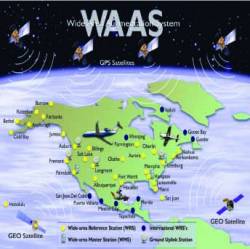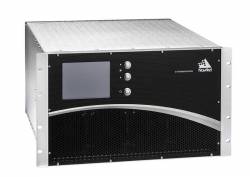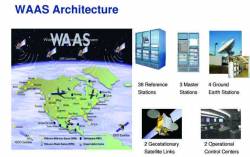
Following in the footsteps of the recent update of the GPS SPS Performance Standard, the Federal Aviation Administration (FAA) has issued a performance standard for the Wide Area Augmentation System (WAAS).
Following in the footsteps of the recent update of the GPS SPS Performance Standard, the Federal Aviation Administration (FAA) has issued a performance standard for the Wide Area Augmentation System (WAAS).
On November 6, the agency reported that it has now published 1,333 localizer performance with vertical guidance (LPV) approach procedures based on WAAS. The LPVs cover runways at 833 airports.
WAAS is the multi-billion-dollar U.S. satellite-based augmentation system (SBAS) developed under an FAA contract by Raytheon Corporation and designed to provide real-time differential corrections, integrity messages (satellite signal “health”), and ranging signals that WAAS-capable equipment can use to improve navigation. It is used primarily by private general-aviation pilots, business and regional aircraft, and some cargo aircraft.
The system includes two geostationary satellites and a network of ground reference stations that monitor GPS satellite signals. WAAS corrects for the GPS satellite position errors, ionosphere delays, and other disturbances in the GPS signals and warns pilots when the satellites are not functioning correctly and should not be used for navigation.
The WAAS performance standard was released October 31 under the signature of Steve Zaidman, FAA vice-president for technical operations. Copies may be downloaded from the Public Materials section on the website of the National Coordination Office for Space-Based Positioning, Navigation, and Timing (PNT).
The document specifies the levels of navigation performance that will be available to suitably equipped users who use both the GPS standard positioning service (SPS) broadcast signals and the WAAS augmentation signal and commits the U.S. government to meeting the minimum levels identified in it.
Leo Eldredge, FAA’s GNSS program manager, characterizes the WAAS PS as “a composite of the current specifications and standards that WAAS already complies with.” According to Eldredge, the National Space-Based PNT Executive Committee (EXCOM) had issued an action item for FAA to publish a WAAS performance standard similar to the GPS SPS PS to formalize the commitment of the USG to provide PNT services based on GPS.
As the GPS system continues to modernize, FAA will update the WAAS PS to include, for instance, the L5 civil signal that will enable dual-frequency positioning in protected aeronautical radionavigation bands. As with the SPS PS, those updates will also follow on the Department of Defense (DoD) process for documenting GPS specifications and standards.
“For civil aviation purposes, we depend on the commitments contained in the SPS PS as the basis for our commitment to provide service through augmentation and the approvals for aviation use of standalone GPS,” Eldredge told Inside GNSS. “Before we could approve use of L5, for either standalone use or as part of an augmented service, the commitment to provide that service would first need to be provided by DoD in a PS.”
Historically, he added, the DoD includes the new signals in a performance standard after the full operational capability (FOC) has been achieved. The Air Force is adding the second civil signal (L2C) and L5 on the IIR-M and IIF space vehicles (SVs), respectively, and later L1C on the GPS III satellites.
“It is not yet known when the new signals will be included in a performance standard or if the current paradigm of two performance standards (SPS PS & PPS PS) will continue to describe the PNT services provided by GPS,” Eldredge said. “Under the current paradigm, we would expect all of the civil signals (L1-CA, L1C, L2C, and L5) to be included in updates to the SPS PS as each new signal achieves FOC (24 SVs operating).”
Eldredge added that the FAA plans to upgrade WAAS to use the L5 signal at the monitoring stations and in aircraft avionics, which will eventually require an update to the WAAS PS. The GPS master schedule currently shows L5 achieving FOC in 2018 and a recent Federal Register announcement regarding use of L2 semi-codeless GPS requires the agency to complete the transition of L2 to L5 by December 31, 2020. WAAS currently uses L2-semicodeless at the monitor stations only.
Another Milestone
The November 6 announcement marks a milestone for WAAS-supported LPV approach procedures, which now surpass the number of approach procedures based on its ground-based predecessor, the Category-I instrument landing system (ILS).
LPV enables pilots to use instrument flight rules for approach and landing operations down to a decision height of 200 feet. FAA is scheduled to declare the full LPV performance (FLP) phase of WAAS operational early next year.
WAAS-capable GPS receivers are specified under FAA Technical Standard Orders 145 and 146. More than 37,000 WAAS-capable units have been sold into the general aviation market and are currently increasing at the rate of about 1,000 units per month, according to Eldredge, and more than 500 business and regional aircraft have been equipped since 2007.
Like the GPS SPS standard, the WAAS PS defines the WAAS signal-in-space (SIS) characteristics, navigation message, and performance requirements. For instance, LPV is designed to provide 16-meter horizontal accuracy and 20-meter vertical accuracy 95 percent of the time. LPV status can also calls for a 6.2-second time to alert when the system is not meeting specified requirements.
Actual performance has exceeded these levels for WAAS, however. For example, vertical error has not been observed to exceed 12 meters in the history of WAAS operational service. Real-time and statistical performance results for WAAS and GPS are available at the FAA Technical Center WAAS Test Bed website.
The agency’s goal is to produce 500 new WAAS procedures each year until every qualified runway in the National Air Space has one.
In addition to the supporting IFR operations, WAAS provides for both more flexible approach and departure routings and more direct, fuel-efficient routings through the air traffic control system. It also provides an improved navigation source for other aviation innovations such as terrain avoidance warning systems and automatic dependent surveillance-broadcast (ADS-B).
Using GPS, an ADS-B–equipped aircraft determines its own position and periodically broadcasts this position and other relevant information to air traffic control stations and other aircraft with ADS-B-in equipment flying in the area.





